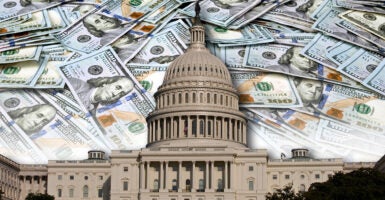It’s been a little over a week since the Committee for a Responsible Federal Budget sent a letter to Kamala Harris and Donald Trump suggesting the two presidential candidates get serious about “skyrocketing” national debt, which now exceeds $35 trillion.
Washington is spending $1.8 trillion more than it collects annually.
“Our publicly held debt will soon surpass the entire size of the U.S. economy, and debt is projected to exceed its previous record, 106% of gross domestic product, in 2027,” the organization’s letter to Harris and Trump warned. “At a projected cost of $892 billion this year, our nation already spends more on interest on the debt than we do on both national defense and all federal spending on children.”
“The costs and promises just keep coming,” Maya MacGuineas, head of the Committee for a Responsible Federal Budget, observed Friday as we chatted over the phone.
As November nears, MacGuineas said, the candidates are dangling “expensive targeted breaks for groups of voters” with a “silly, cynical patchwork of fiscal giveaways.”
Committee for a Responsible Federal Budget crunched the numbers from the Harris and Trump campaign troves and reported that Harris scored better than Trump.
The fiscal watchdog group factored three outcomes—low impact, high impact, and in between—of each candidate’s proposals.
It figured the impact on the national debt for Plan Kamala could be as low as zero or as high as $8.1 trillion over 10 years starting in 2026. For Trump, the range could be as low as $1.45 trillion or as high as $15.15 trillion over the same period.
That would be on top of the $1.8 trillion or so in debt that we already accumulate each year.
Since the letter went out, MacGuineas noted, there has been another natural disaster (Hurricane Milton). Harris also promised to have Medicare fund at-home, long-term care and Trump promised a new tax break on car-loan interest. So those estimates can only grow.
MacGuineas said the longer Washington puts off addressing America’s overindebtedness, the more painful the remedy will be.
Because really, the only way to eliminate the money gap and put federal spending on a sustainable path would be to address entitlement spending. But you don’t hear either candidate talking about fixing Social Security or Medicare. Instead, you hear about how they want to give away more money they don’t have.
Part of the problem is there is no crisis, just more red ink every year; our finances resemble the frog in the pot on top of a fire.
But it’s also true that with no crisis, this would be a perfect time to course-correct. The economy is strong enough to absorb the cost of what needs to be done.
Shortly after MacGuineas and I spoke, The Wall Street Journal reported that JPMorgan Chase Chief Financial Officer Jeremy Barnum said on a conference call that after a recent interest rate cut, the U.S. economy is in a “kind of Goldilocks” situation.
Inflation is at 2.44% right now. But when interest rates climb, the cost of paying off the mountains of U.S. debt will climb as well.
So this would be a great time to right the ship, except that it’s an election year and neither party wants to talk about paying the piper.
Republicans aren’t talking about cutting government to right the ship, MacGuineas noted, and Democrats aren’t pushing for the broad tax hikes necessary to pay for their programs.
I asked MacGuineas: What should voters be pushing for?
A pledge from candidates, she responded, and it’s simple: “No new borrowing until they fix this situation, barring emergencies.”
That makes so much sense, you know it won’t happen.
COPYRIGHT 2024 CREATORS.COM
We publish a variety of perspectives. Nothing written here is to be construed as representing the views of The Daily Signal.




























